Critical Thinking for Engineers
Engineers are specialists in technical information. As the complexities of problems increase, there has been an increasing need for engineers to apply critical thinking in the context of problem solving. This article demonstrates the value and use of developing abstract thought in engineering, especially for students

Introduction
In school, the most widely used, or at least the most reputable method for solving problems is “Critical Thinking.” From understanding the works of a long dead philosopher to solving differential equations, “Critical Thinking” is like some sort of intellectual panacea. Although everyone can agree that “Critical Thinking” is usually a good thing, it is difficult to explain exactly what it is and even more difficult to teach it.
For most engineers, problem solving is essentially their profession. Critical thinking and abstract thought, then, are invaluable tools, which complement an engineer’s technical expertise. In this paper, our first goal is to define what exactly critical thinking is. From there, we will discuss examples, which highlight the importance of abstract thought as well efforts to teach this in the classroom. Finally, we will look at how this can be applied to our Senior Project and perhaps future work in general.
To begin, we will look at two definitions of critical thinking. In her 2002 article, Jessop argues that critical thinking is comprised of three major skills: analysis, synthesis, and evaluation. She goes on to quote a statement by Scriven (n.d.) to define the term more explicitly:
Critical Thinking is the intellectually disciplined process of actively and skillfully conceptualizing, applying, analyzing, synthesizing, and/or evaluating information gathered from, or generated by, observation, experience, reflection, reasoning, or communication, as a guide to belief and action.(as quoted in Jessop, 2002, p. 141)
Analysis is breaking down the problem into parts and finding the relationships between them. Synthesis is thinking about other ways to solve the problem either by incorporating new information or combining the parts in a different way. Finally, evaluation is making a judgment about the results using the evidence at hand.
According to Scriven (n.d.), then, critical thinking is the combined process of analysis, synthesis, and evaluation. Since we are trying to use critical thinking as “a guide to belief and action,” synthesis, or the generation of new ideas or solutions, is a necessary component. However, creating these new solutions is difficult, if not impossible, without understanding the problem, which leads to analysis. The process of critical thinking, though, does not stop at synthesis. Out of the results from the synthesis stage, some may be better than others. Moreover, it is possible that none of the results actually solve the problem. Because of this, it is necessary to evaluate the results in order to find the best answer. To better understand this definition, we will apply this to an example.
Let’s assume we want an egg for breakfast. For analysis , the parts of this process might be putting butter in a pan, breaking the egg, and then cooking it. For synthesis , there are many different ways to prepare eggs. For example, we could whisk the egg to make scrambled eggs, or maybe we want hard boiled eggs instead. Finally, we need to evaluate our result. There are many different criteria for this, such as which one takes the least amount of time, which is the most delicious, which is the healthiest, etc. In order to apply critical thinking to this problem, the goals are to understand the problem, find possible solutions, and evaluate the result.
For comparison, we now look at another definition of critical thinking. Qiao (2009) writes, “When one used the methods and principles of scientific thinking in everyday life, then he was practicing critical thinking. So scientific and critical thinking are the same thing…” The first thing that comes to mind when thinking about “scientific thinking” is the scientific method, so at first, this comparison seems a little odd. For reference, the steps of the scientific method are presented as follows (Wikipedia, n.d.):
- Define a question
- Gather information and resources (observe)
- Form an explanatory hypothesis
- Test the hypothesis by performing an experiment and collecting data in a reproducible manner
- Analyze the data
- Interpret the data and draw conclusions that serve as a starting point for new hypothesis
- Publish results
- Retest (frequently done by other scientists)
In the steps above, we see some similarities with the earlier definition of critical thinking. Earlier, we stated that critical thinking was composed of analysis, synthesis, and evaluation. While engineers typically begin with problems instead of questions, the gathering of information and resources is definitely a part of analysis. In both cases, understanding the problem or question is a priority. In critical thinking, the next step would be synthesis. A scientist may be trying to answer a question by forming a hypothesis, but the need to imagine different possibilities and find an answer that fits is the same in engineering. Lastly, steps 4-6 could be considered one way to evaluate the results from synthesis. While a scientist may test his or her hypothesis with experiments, an engineer may run simulations or create prototypes. The point in either case, though, is to make sure is to ensure the ideas from earlier actually work.
Although we defined critical thinking from an engineer’s perspective, it should not be surprising that we can apply it loosely in other disciplines such as science. After all, the capacity for critical thinking is not limited to or only useful for engineers alone. Writers, philosophers, mathematicians, and many other disciplines make use of critical thinking as well. Even if the process is slightly different for each, at the very least, analysis, synthesis, and evaluation lie at the heart of critical thinking.
As a technical example of critical thinking, let us examine a problem a Tufts University student encountered while doing research over the summer. This student was writing the image processing code for a robot, which had a camera mounted on it.
The code to retrieve the video and display it was already written, so the student only had to focus on the image processing part. As a simple test, the student wrote a piece of code to find the number of black pixels in a video frame. The code was easy to test since all the pixels could be made black by covering up the camera. The problem occurred when the student’s code tried to count all the pixels when the camera was covered up. In this case, all the pixels should be black, but the student recorded only a fraction of that number.
So how did the student use critical thinking to solve the problem? First, he took into account all of the available information and tried to find possible sources of the problem. The input was a video frame with an apparent size of 480 x 640 pixels, which matched the output displayed. Repeating the test for black pixels consistently returned the same fraction. When the student modified his code to check for pixels of any colors, the result found the expected number of pixels, so at first the problem appeared to be related to detecting the black pixels. The student, however, had tested that part of the code thoroughly, and was fairly confident that it was not the source of the problem.
Continuing on with his analysis, the student decided to directly save the video frame and display it. Upon seeing the result, the student at once saw the problem and found a solution. While the given video frame had room for 480 x 640 pixels, the actual image was stored in the upper left hand corner as a 240 x 320 image. Thus, the student’s code was correct, as he originally surmised, and it was actually returning the correct number. The code to display the video, it turns out, expected this input, and resized the image to the 480 x 640 video feed that the student originally saw.
From there, the rest of the problem was straightforward. For synthesis, the student decided to use the upper left corner of the given images and ignore the rest of the pixels. The result was more efficient than the original code, since it only had to process a 240 x 320 image and it ignored the pixels that were skewing the results. This example demonstrates the importance of analysis in critical thinking. Without an understanding of the problem, it is unlikely that the student would have found a solution by starting with the synthesis step. In this case, the solution and the tests to make sure it worked were relatively simple, so the synthesis and evaluation steps were not as important. Nevertheless, applying all of these steps in tandem allowed the problem to be successfully solved.
Engineering Curriculum
For the most part, critical thinking has typically been something reserved for the liberal arts, especially English and Philosophy. Even on standardized tests like the SATs, there is a critical reading section. However, as we discussed earlier, critical thinking is not limited to the liberal arts; it is also an integral part of the sciences and engineering.
Recently, the Accreditation Board for Engineering and Technology (ABET) has been pushing for more emphasis on communication skills and understanding the global context of today’s problems in the engineering curriculum. Previously, and even now, the ABET accreditation process acknowledged schools that trained students not only to be able to apply their technical knowledge, but also lead and work well in teams. ABET believes that their new objectives can be achieved through the inclusion of more writing and critical thinking in the engineering classroom (Gunnink & Bernhardt, 2002).
Although most people agree that critical thinking should be a focus in school, there are a variety of proposed methods, but no single class or solution stands out. Even though we have been treating critical thinking as an individual effort, a few papers have suggested the use of group discussions and forums in order to encourage critical thinking (Radzi et al., 2009; Jacob et al, 2009). After defining critical thinking in her article, Jessop (2002) suggests a course based on Brainstorming and Critical Reading. For the brainstorming section, students are given a problem, and then, over the course of a few weeks, students must engineer a solution. For the critical reading section, students are given a number of journal articles to read and evaluate. Naturally, the brainstorming half is mainly concerned with the synthesis aspect of critical thinking while the critical reading half focuses on the analysis aspect (Jessop, 2002). The hope, of course, is that by practicing these steps, the students will become better at critical thinking in the future.
As mentioned earlier, Qiao (2009) was writing on critical thinking in schools in China. Qiao goes on to state, “The nature of authority has two forms: textbook authority and teacher authority. Laws and rules in textbook are golden and precious, beyond any manner of doubt. Science teacher is the prolocutor of truth.” (2009, p. 115). In order to promote critical thinking and a sense of skepticism, Qiao suggests a History, Philosophy, and Science (HPS) Education approach. In addition to the usual Science that students learn about, Qiao (2009) believes it is valuable to learn about both the History and Philosophy behind these advancements. While Jessop’s (2002) strategy is purely from an engineer’s perspective, Qiao’s approach relies on the idea that critical thinking is not restricted to engineers. Instead, the capacity for critical thought is developed through studies in history and philosophy.
Despite the differences in each method, the goal is the same. In order to tackle increasingly difficult problems, engineers will require more than just technical knowledge. To this end, there is a need for teachers and experts, whose job is to train these engineers, to bring critical thinking into the classroom.
Application to Senior Project
In this paper, we have attempted to answer questions like, “What is critical thinking?” and “Why is it important?” As we stated before, critical thinking can be thought of as similar to the scientific method, but its main points are the problem definition and understanding, the search for solutions, evaluation, and iteration. Since critical thinking is a powerful tool in problem solving, we have seen recent efforts to include it in the engineering curriculum. The final question we want to answer is, “How does this apply to our senior project?
The answer to this lost question is relatively simple. Each of our senior projects , if properly scoped and planned, should aim to solve a problem. In light of this, we should strive to solve these problems intelligently, which is to say, using critical thinking. This means fully researching and understanding the problem, creating new solutions and finding old ones, and evaluating the result. When our result is a failure, we go back, look for other solutions, and try again until we have solved the problem. So we can see that critical thinking is an important, if not essential, part of our senior project.
Cited References
- Gunnink, B., & Bernhardt, K. L. S. (2002). Writing, critical thinking, and engineering curricula. In Frontiers in Education , 2002. FIE 2002. 32nd Annual (Vol. 2, pp. F3H–2–F3H–7 vol.2). Presented at the Frontiers in Education, 2002. FIE 2002. 32nd Annual. DOI: 10.1109/FIE.2002.1158211
- Jacob, S. M., Lee, B., & Lueckenhausen, G. R. (2009). Measuring Critical Thinking Skills in Engineering Mathematics using online forums. In 2009 International Conference on Engineering Education (ICEED) (pp. 225–229). Presented at the 2009 International Conference on Engineering Education (ICEED). DOI: 10.1109/ICEED.2009.5490577
- Jessop, J. L. P. (2002). Expanding our students’ brainpower: idea generation and critical thinking skills. IEEE Antennas and Propagation Magazine , 44(6), 140–144. DOI: 10.1109/MAP.2002.1167273
- Qiao, C. (2009). Science Education and Fostering of Critical Thinking in China. In Second International Conference on Education Technology and Training , 2009. ETT ’09 (pp. 114–117). Presented at the Second International Conference on Education Technology and Training, 2009. ETT ’09. DOI: 10.1109/ETT.2009.25
- Radzi, N. M., Abu, M. S., & Mohamad, S. (2009). Math-oriented critical thinking skills in engineering. In 2009 International Conference on Engineering Education (ICEED), (pp. 212–218). Presented at the 2009 International Conference on Engineering Education (ICEED). DOI: 10.1109/ICEED.2009.5490579
- Scientific Method. (n.d.). In Wikipedia. Retrieved December 18, 2012, from http://en.wikipedia.org/wiki/Scientific_method
- Scriven, M. & Paul, R. (n.d.) “Defining Critical Thinking.” National Council for Excellence in Critical Thinking Instruction. Retrieved from http:/lwww.criticalthinking.orgiuniversitylunivclasslDe~ning.html
Additional Resource
- Accreditation Board for Engineering and Technology (ABET). (n.d.) Retrieved from http://www.abet.org/
- Articles > 1. Design Process > Critical Thinking for Engineers
Search the Handbook:
Handbook overview.
- Introduction and Acknowledgements
- Senior Capstone Projects Summary for the 2022-23 Academic Year
- Senior Capstone Projects Summary for the 2021-22 Academic Year
- Senior Capstone Projects Summary for the 2020-21 Academic Year
- Senior Capstone Projects Summary for the 2019-20 Academic Year
- Senior Capstone Projects Summary for the 2018-19 Academic Year
- Senior Capstone Projects Summary for the 2017-18 Academic Year
- Senior Capstone Projects Summary for the 2016-17 Academic Year
- Senior Capstone Projects Summary for the 2015-16 Academic Year
- Senior Capstone Projects Summary for the 2014-15 Academic Year
- Senior Capstone Projects Summary for the 2013-14 Academic Year
- Senior Capstone Projects Summary for the 2012-13 Academic Year
- 1. Design Process
- 2. Management
- 3. Technologies
- 4. Communications And Life Skills
- 5. Tech Notes
- Electrical and Computer Engineering Design Handbook

Disclaimer | Non-Discrimination | Privacy | Terms for Creating and Maintaining Sites
Advertisement
Strengthening critical thinking in engineering students
- Original Paper
- Published: 25 March 2019
- Volume 13 , pages 995–1012, ( 2019 )
Cite this article

- Patricia Caratozzolo ORCID: orcid.org/0000-0001-7488-6703 1 ,
- Alvaro Alvarez-Delgado 2 &
- Samira Hosseini 3 , 4
1291 Accesses
17 Citations
1 Altmetric
Explore all metrics
Governments, accreditation agencies and employers are increasingly interested in the development of a set of soft skills in students among which critical thinking is found to be a highly relevant skill for engineers in order to meet the requirements of future job markets. In addition, there is great effort in the universities to include cognitive tools in their different engineering programs for training and developing these soft skills. The purpose of this study is to design strategies that develop critical thinking in engineering students, using three specific cognitive tools: (1) the enrichment of the vocabulary corpus; (2) the formation of coherent speech habits; and (3) the practice of argumentation and opinion. To achieve the objectives of this work, activities of the artistic-narrative modality of thinking in addition to the traditional logical-scientific modality of thinking were incorporated in the classroom. The results showed a substantial improvement in the development of the particular soft skill, critical thinking, in engineering students.
This is a preview of subscription content, log in via an institution to check access.
Access this article
Price includes VAT (Russian Federation)
Instant access to the full article PDF.
Rent this article via DeepDyve
Institutional subscriptions

Similar content being viewed by others

Is Critical Thinking a Skill or a Way to Develop Skills? An Overview in Engineering Education

Enhancing Scientific Thinking Through the Development of Critical Thinking in Higher Education

Applying Cognitive Science to Critical Thinking among Higher Education Students
World Economic Forum: The Future of Jobs, Employment, Skills and Workforce Strategy for the Fourth Industrial Revolution, International Report, January 2016. Accessed 9 Oct 2018
Savannah State University: The Write Attitude. https://www.savannahstate.edu/qep/ (2018). Accessed 24 Oct 2018
Massachusetts Institute of Technology: MIT Open Course Ware. https://ocw.mit.edu/index.htm . Accessed 16 Oct 2018
The Occupational Information Network (O*NET), US Department of Labor: Employment and Training Administration. https://www.onetonline.org . Accessed 24 October 2018
Trosset, C.: Obstacles to open discussion and critical thinking: the Grinnell College Study. Change 30 (5), 44–50 (1998)
Article Google Scholar
Moore, W.: My Mind Exploded: Intellectual Development as A Critical Framework for Understanding and Assessing Collaborative Learning. Washington Center for Improving the Quality of Undergraduate Education. http://www.evergreen.edu/washcenter/resources/acl/iia.html (2004). Accessed 9 Oct 2018
Seemiller, C., Grace, M.: Generation Z Goes to College. Jossey-Bass, New York (2016)
Google Scholar
Weiler, A.: Information-Seeking behavior in Generation Y students: motivation, critical thinking and learning theory. J Acad Librariansh 31 (1), 46–53 (2004)
Egan, K.: Mentes Educadas. Paidós, España (2000)
Frey, T.: The future of education. The Future Leadership Institute. https://fli.institute/2009/05/03/the-future-of-education-2/ (2009). Accessed 24 Oct 2018
Bruner, J.S.: Actual Minds, Possible Worlds. Harvard University Press, Cambridge (2009)
Vygotsky, L.S: Thought and language (A. Kozulin, Trans.) Cambridge, MA: MIT Press (1986)
Paul, R., Elder, L.: The Miniature Guide of Critical Thinking. Concepts and Tools. https://www.criticalthinking.org/files/Concepts_Tools.pdf (2006). Accessed 24 Oct 2018
Thomson, A., Ralston, P., Lloyd Hieb, J.: Engaging Freshman engineers using the Paul-Elder framework for Critical Thinking. In: Proceedings of the 2012 American Society for Engineering Education Annual Conference: article # 3648 (2012)
Dewey, J.: Cómo pensamos. Nueva exposición de la relación entre Pensamiento reflexivo y proceso educativo. Paidós. Cognición y desarrollo humano, España (1989)
Kurland, D.: How the Language Really Works: The Fundamentals of Critical Reading and Effective Writing. http://www.criticalreading.com/critical_reading_thinking.htm . Accessed 9 Oct 2018
Guerin, W., Labor, E., Morgan, L., Reesman, J., Willingham, J.: A Handbook of Critical Approaches to Literature. Oxford University Press, New York (1999)
Laban, R.A.: Vision of Dynamic Space. Compiled by Lisa Ullmann. The Falmer Press, London (1984)
Vygotsky, L.: The Development of Higher Psychological Processes. Crítica, España (2000)
Corpus of Contemporary American English. COCA. https://corpus.byu.edu/coca/ . Accessed 24 Oct 2018
Corpus iWeb: https://corpus.byu.edu/iweb/ Accessed 9 Oct 2018
Word and Phrase: https://www.wordandphrase.info/frequencylist.asp . Accessed 19 Oct 2018
REAL ACADEMIA ESPAÑOLA: Banco de datos CREA. Corpus de referencia del español actual. http://www.rae.es . Accessed 19 Oct 2018
AAC&U: VALUE Rubrics. https://www.aacu.org/value-rubrics . Accessed 16 Oct 2018
Cohen, L., Manion, L., Morrison, K.: Research Methods in Education. Routledge, London (2002)
Book Google Scholar
Frequencies Corpus CREA. http://corpus.rae.es/lfrecuencias.html . Accessed 16 Oct 2018
Cant, A.: Unswaddling Pedagogy: Imagining a New Beginning to the Practice of Imaginative Education. Thesis for the degree of Ph.D. Simon Frasier University, pp. 84–85 (2016)
Gross, J.: Time to Talk: Implementing Outstanding Practice in Speech, Language and Communication. Routledge, Savannah State University, London (2013)
Evans, J.D.: Straightforward Statistics for the Behavioral Sciences. Brooks/Cole, Pacific Grove (1996)
Caratozzolo, P., Alvarez, A.: A New transdisciplinary approach to foster soft skills in engineering: using critical reading micro-workshops. In: 2018 World Engineering Education Forum-Global Engineering Deans Council (WEEF-GEDC), pp. 1–6 (2018)
Caratozzolo, P., Alvarez, A., Hosseini, S.: Strengthening critical thinking in students of engineering careers. In: Electronic Proceedings of the International Workshop on Educational Innovation in Engineering and Sciences. ISBN 978-2-9548927-5-7 (2018)
Hagerty, J., Rockaway, T.D.: Adapting entry level engineering courses to emphasize critical thinking. J. STEM Educ. Innov. Res. 13 (2), 25–34 (2012)
Accreditation Board for Engineering and Technology: Competence Model for Program Evaluators. http://www.abet.org/program-evaluators/become-a-program-evaluator/how-to-become-a-pev/competency-model-for-program-evaluators/ . Accessed 24 Oct 2018
Download references
Acknowledgements
The authors would like to acknowledge the financial and the technical support of Writing Lab, TecLabs, and Tecnologico de Monterrey in the production of this work. The authors would like to acknowledge the financial support of the Novus Grant with PEP no. PHHT090-17CX00001, TecLabs, Tecnologico de Monterrey, in the production of this work. The authors would like to acknowledge the students of the courses M2003, TE2042 and TE3053 who so kindly and selflessly participated in this study.
Author information
Authors and affiliations.
Mechatronics Department, School of Engineering, Tecnologico de Monterrey, Mexico, Mexico
Patricia Caratozzolo
Language Department, School of Social Sciences, Tecnologico de Monterrey, Mexico, Mexico
Alvaro Alvarez-Delgado
Writing Lab, TecLabs, Vicerrectoría de Investigación y Transferencia de Tecnología, Tecnologico de Monterrey, Monterrey, NL, Mexico
Samira Hosseini
Escuela de Ingeniería y Ciencias, Tecnologico de Monterrey, Monterrey, NL, Mexico
You can also search for this author in PubMed Google Scholar
Corresponding authors
Correspondence to Patricia Caratozzolo or Samira Hosseini .
Additional information
Publisher’s note.
Springer Nature remains neutral with regard to jurisdictional claims in published maps and institutional affiliations.
Rights and permissions
Reprints and permissions
About this article
Caratozzolo, P., Alvarez-Delgado, A. & Hosseini, S. Strengthening critical thinking in engineering students. Int J Interact Des Manuf 13 , 995–1012 (2019). https://doi.org/10.1007/s12008-019-00559-6
Download citation
Received : 18 January 2019
Accepted : 02 March 2019
Published : 25 March 2019
Issue Date : 01 September 2019
DOI : https://doi.org/10.1007/s12008-019-00559-6
Share this article
Anyone you share the following link with will be able to read this content:
Sorry, a shareable link is not currently available for this article.
Provided by the Springer Nature SharedIt content-sharing initiative
- Critical thinking
- Cognitive flexibility
- Educational innovation
- Soft skills in engineering
- Find a journal
- Publish with us
- Track your research

Contact/Feedback
- Mission & Vision
- Discover IEEE-USA
- Giving Opportunities
- Advertise with Us
- Volunteer Leaders
- Brand Media
- Visiting IEEE-USA
Careers Home
For consultants, for entrepreneurs.
- Career Webinars
- IEEE-USA Salary Service
- Career eBooks
- FE/PE Training Materials NEW
- Career & Professional Development
- Licensure & Registration
- Consultant Finder
- Networks by IEEE Region
- Networks by State
- Start a Consultants Network
- IEEE-USA Consultants Newsletter Archive
- Federal & Other Resources
- eBooks for Entrepreneurs
- Employment Networks
- Start Your Employment Network
- Help for the Unemployed or At-Risk Member
Public Policy Home
Public policy resources, fellowships & internships, policy events.
- Policy Priorities
- Policy Positions
- Public Policy News
- Policy Webinars
- White Papers
- AI Policy (AIPC)
- Communications Policy (CCP)
- Energy Policy (EPC)
- Entrepreneurship & Innovation (EPIC)
- Intellectual Property (IPC)
- R&D Policy (RDPC)
- Transportation & Aerospace
- Congressional Fellowships
- State Department Fellowships
- USAID Fellowships
- WISE Internships
- Government Fellows Committee
- Congressional Visits Day (CVD)

Volunteers Home
Get involved, awards & recognition.
- BOD Nominations
- MOVE Community Outreach
- Board Resources
- Volunteer Resources
- Youth Resources
- Professionalism Awards
- Technical Achievement Awards
- Literary Awards
- IEEE-USA InSight
- News Releases
- eBooks & Audiobooks
- Advertise With Us
- Email Newsletters
- IEEE-USA In The News
- Calendar Overview
- Conferences
- Policy Webinars & Events
- Special Events

Public Policy
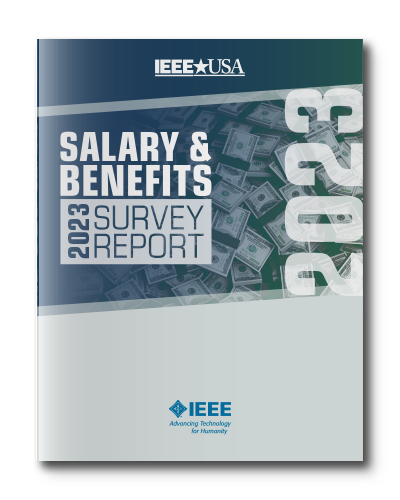
- Whitepapers
- Visit IEEE-USA InSight
- Search for:
Critical Thinking Skills for Engineers – Book 1: Analytical Skills
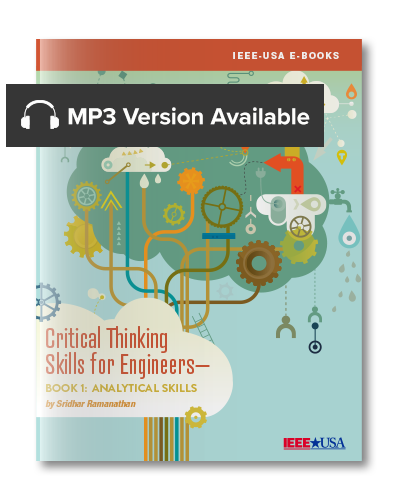
Author: Sridhar Ramanathan | Download FREE audiobook
In this first book in our series on critical thinking skills, we delve into analytical skills—the ability to examine something carefully—whether it is a problem, a set of data, or text.

E-Book (PDF)
Member: FREE Non-Member: $4.99
Description
We live in times when facts, claims, opinions, and even data are vying for our attention—ultimately aiming to drive us to some desired action—to purchase something, go somewhere, vote for someone, experience something, build something, etc. If we’re not careful, we are acting on someone else’s best interests—not necessarily your own. And if you are an engineer, or in a technical field, then critical thinking is all the more important to delivering the most effective and potentially novel, break-through solution you can. In this book series, we explore the key aspects of critical thinking: analytical skills, data analysis, interpretation, judgment, questioning evidence, recognizing similarities and differences, creativity, communication, and skepticism. In this first book, we delve into analytical skills—the ability to examine something carefully—whether it is a problem, a set of data, or text. People with analytical skills can examine information, and then understand what it means, and what it represents. That aptitude allows for much richer, better solutions to real-world challenges. Let’s start now with the elements of analytical thinking.
You may also like…
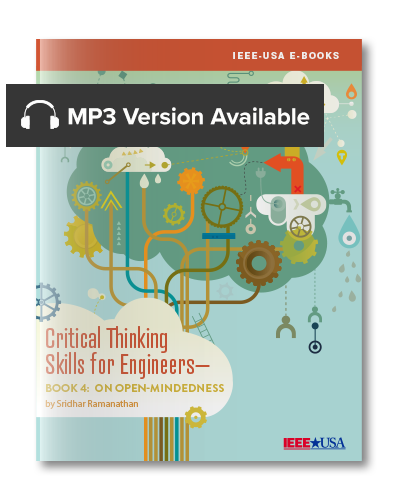
Critical Thinking Skills for Engineers – Book 4: On Open-mindedness
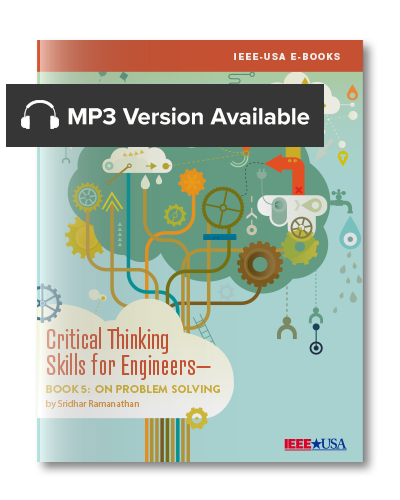
Critical Thinking Skills for Engineers – Book 5: On Problem Solving
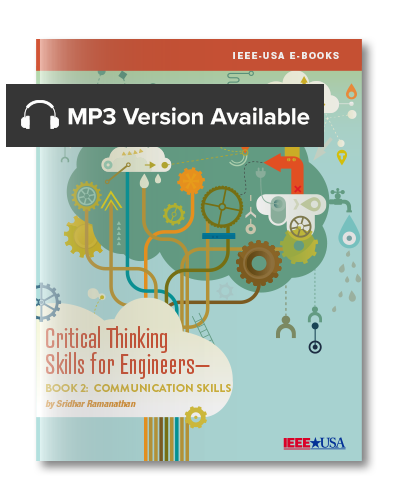
Critical Thinking Skills for Engineers – Book 2: Communication Skills
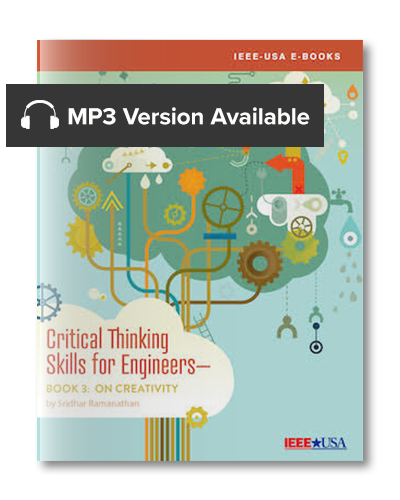
Critical Thinking Skills for Engineers – Book 3: On Creativity
Related products.
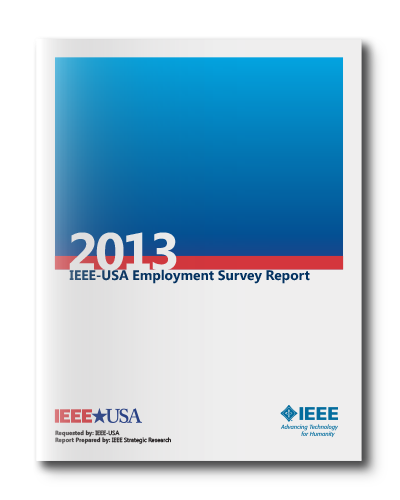
2013 IEEE-USA Employment Survey Report
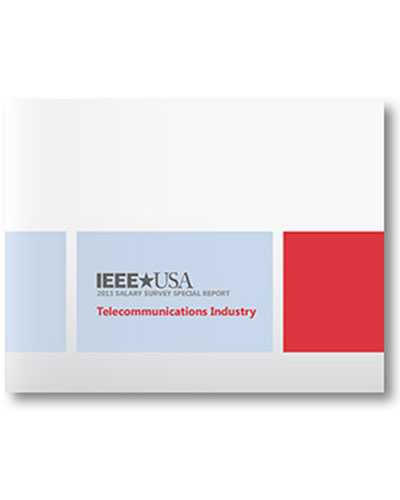
2013 Telecommunications Industry Salary Report

Starting Your Start-Up – Book 2: Market Size and Strategy

IEEE-USA is an organizational unit of IEEE, created in 1973 to support the career and the public policy interests of IEEE’s U.S. members. IEEE is the world’s largest technical professional organization dedicated to advancing technology for the benefit of humanity.
Next Conference

IEEE AIIoT 2024
29 may - 31 may, next webinar.
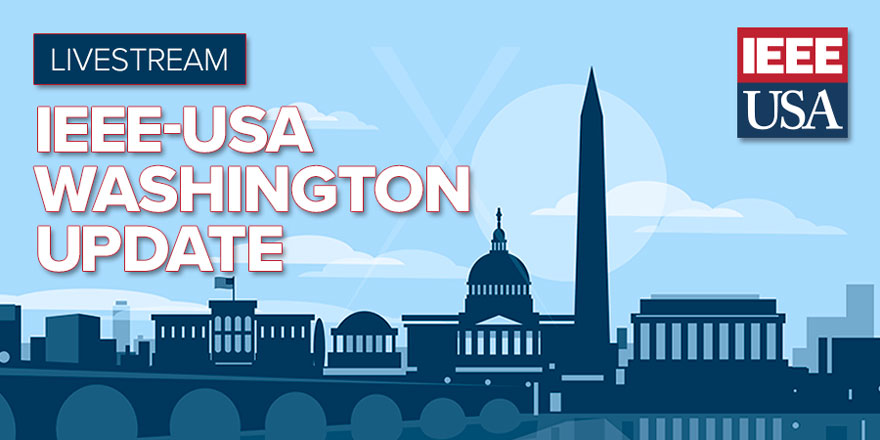
IEEE-USA Washington Update
6 june @ 1:00 pm - 2:00 pm.
- Thinker's Guides
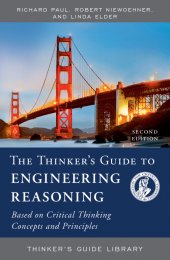
The Thinker's Guide to Engineering Reasoning (Based on Critical Thinking Concepts and Tools)
Second edition richard paul, robert niewoehner, and linda elder order from rowman & littlefield here., contact info for rowman & littlefield:.
- Toll free: (800) 462-6420 ext. 3024
- Fax: (800) 338-4550
- Orders to [email protected]
- Queries to [email protected]
The Thinker’s Guide to Engineering Reasoning applies critical thinking concepts to the field of engineering. Students and professionals across engineering will find their analytical abilities enhanced by the engaging authoritative framework set forth by Richard Paul and Linda Elder. For engineers to properly reason through engineering projects requires strong analytic skills. The best engineers are clear about their purposes, gather sufficient information, and develop innovations. This requires critical reasoning and this guide offers tools essential to this process. As part of the Thinker’s Guide Library, this book advances the mission of the Foundation for Critical Thinking to promote fairminded critical societies through cultivating essential intellectual abilities and virtues across every field of study across world. Rowman & Littlefield Publishers / The Foundation for Critical Thinking Pages: 54 • Trim: 5 1/2 x 8 978-0-944583-33-3 • Paperback • January 2013 • $21.99 • (£14.95) 978-1-5381-3379-8 • eBook • June 2019 • $20.50 • (£13.95) Series: Thinker's Guide Library
Additional Information About: The Thinker's Guide to Engineering Reasoning (Based on Critical Thinking Concepts and Tools)
Normal 0 false false false EN-US X-NONE X-NONE MicrosoftInternetExplorer4
This thinker’s guide is designed for administrators, faculty, and students. It contains the essence of engineering reasoning concepts and tools. For faculty, it provides a shared concept and vocabulary. For students, it is a thinking supplement to any textbook for any engineering course. Faculty can use it to design engineering instruction, assignments, and tests. Students can use it to improve their perspective in any domain of their engineering studies.
Generic engineering thinking skills apply to all technological disciplines. For example, engineering thinkers are clear as to the purpose at hand and the question at issue. We question information, conclusions, and points of view. We strive to be accurate, precise, and relevant. We seek to think beneath the surface, to be logical, and objective. We apply these skills to our reading and writing as well as to our speaking and listening. We apply them in professional and personal life.
Engineers and scientists are quite comfortable working within the context of conceptual models. We employ thermodynamic models, electrical models, mathematical models, computer models or even physical models fashioned from wood or clay. Here we apply a model of the way in which we think, an architecture whose purpose aids the analysis and evaluation of thought, that we might improve our thought.
It is important for the field of engineering to be understood as systems of overlapping and interrelated ideas, rather than isolated and different fields of knowledge. Moreover, it is important to recognize and effectively deal with the multiple environmental, social and ethical aspects that complicate responsible engineering. Accordingly, it is time for engineering educators to realize that effective engineering instruction cannot be based on memorization or technical calculation alone. Rather, it is essential that engineering students develop the generalizable critical thinking skills and dispositions necessary for effectively and professionally reasoning through the complex engineering issues and questions they will face as engineers.
Critical Thinking Skills for Engineers - Book 4: On Open-mindedness
Ieee account.
- Change Username/Password
- Update Address
Purchase Details
- Payment Options
- Order History
- View Purchased Documents
Profile Information
- Communications Preferences
- Profession and Education
- Technical Interests
- US & Canada: +1 800 678 4333
- Worldwide: +1 732 981 0060
- Contact & Support
- About IEEE Xplore
- Accessibility
- Terms of Use
- Nondiscrimination Policy
- Privacy & Opting Out of Cookies
A not-for-profit organization, IEEE is the world's largest technical professional organization dedicated to advancing technology for the benefit of humanity. © Copyright 2024 IEEE - All rights reserved. Use of this web site signifies your agreement to the terms and conditions.
Trips to Italy, Israel highlight the benefits of Immersion Vanderbilt
Media inquiries.
- 615-322-6397 Email
Latest Stories
- WATCH: One community, diverse perspectives
- The Choice: Meacham and Geer on 2024
- Why have venture capitalists become so founder-friendly?
Share this Story
May 15, 2024, 9:20 AM
More than 20 Vanderbilt engineering students recently visited Italy during their spring break to not only see some iconic structures, but also learn the engineering behind the Pantheon and Venice’s sophisticated floodgates so they could apply that knowledge to future engineering projects of their own.
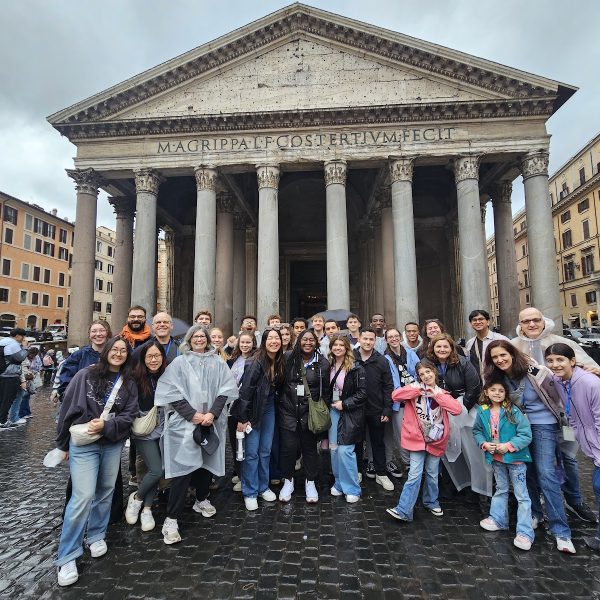
The trip was part of an inaugural class taught this semester in the Department of Civil and Environmental Engineering . It sought to give the 22 students a deeper understanding of the engineering behind some of Italy’s structures, such as the ancient Pantheon and MOSE project designed to protect the city of Venice from flooding. The MOSE project is an integrated system consisting of rows of mobile gates that uses air pressure to keep water levels in check.
As part of their class assignments, the students worked in groups to design floodgates as well as build and test concrete dome prototypes based on their studies of how the Pantheon was constructed. The class was originally scheduled for 15 students, but instructors increased the number because of interest.
“We wanted to help students understand the history and the beauty of structural engineering with the hope that they will be able to better work with architects to achieve beautiful and structurally sound buildings in their careers,” said Lori Troxel, professor of the practice of civil and environmental engineering and a class instructor.
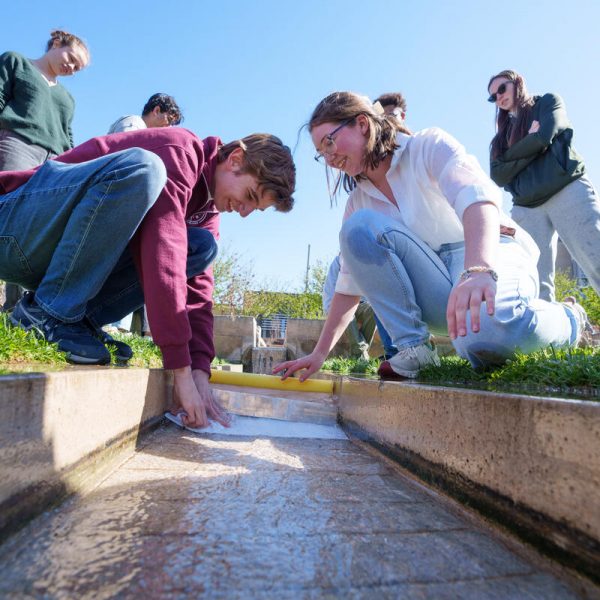
Read the full story here
Recent excursions to Italy and Israel led by Troxel exemplify a commitment to incorporate experiential learning into the Vanderbilt student experience.
Some students on both trips led by Troxel used the spring break travel to take part in an experiential learning opportunity through an academic degree requirement called Immersion Vanderbilt.
Immersion Vanderbilt was created to provide new ways for students to develop better critical thinking skills and a stronger ability to navigate a changing world. The program steered students toward the travel opportunity while allowing Troxel to teach outside of traditional classroom walls.
“Immersion Vanderbilt encourages faculty to take students out into the world to see firsthand the impact of engineering design. It is a reminder that Vanderbilt values experiences outside the classroom,” Troxel said.
“Immersion Vanderbilt helps reinforce the idea that experiential education adds a significant benefit to the theory and design learned in the classroom,” she added.
For example, students who traveled to Italy with Troxel gained first-hand knowledge that will help them in future careers. Several students on the trip aspire to be civil engineers, and they are going to be designing protections for cities that must adapt to climate change. Some students incorporated their time in Italy into their senior design projects.
Seeing the MOSE flood protection in Venice helped students understand not only the importance of protecting cities, but how difficult it is, Troxel said. She noted that students who traveled to Israel saw how a country with very few water resources was able to become rich in water through desalination and water reuse.
“Immersive experiences help students realize they can use their creativity and engineering skills to provide a better life for people around the world,” Troxel said.
Keep Reading
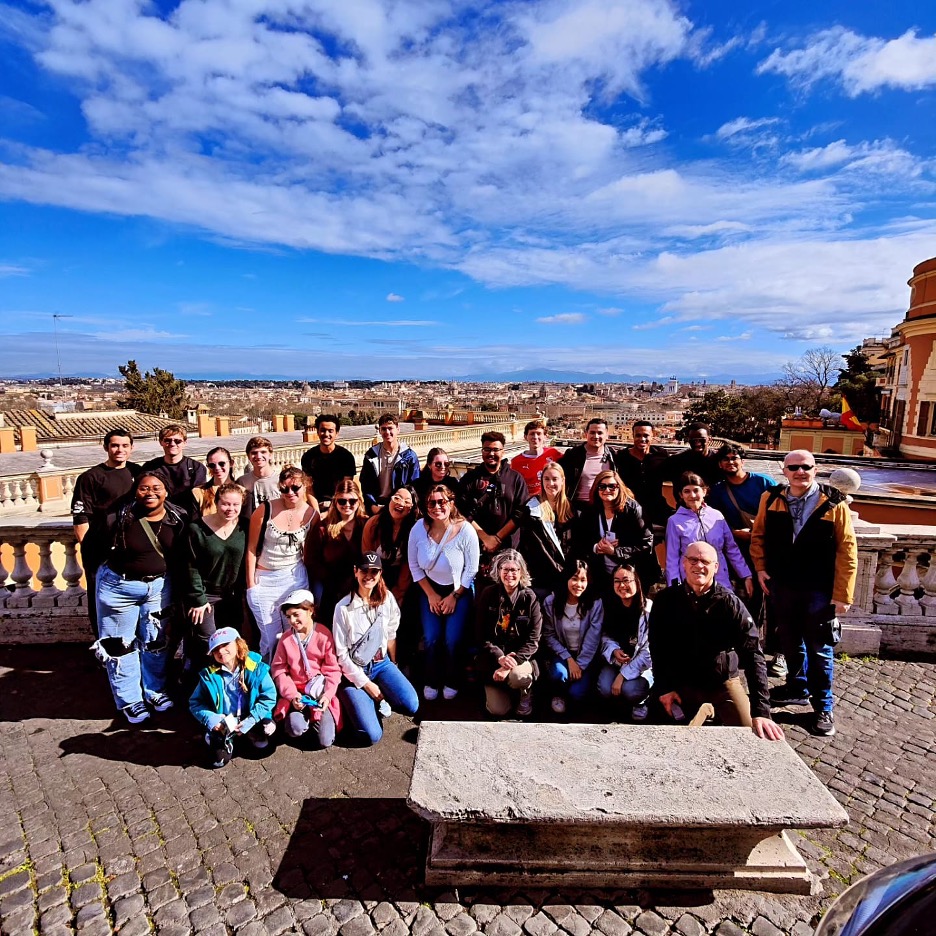
66 Vanderbilt faculty grants empower student innovation through immersion

Get to Work: How Immersion Vanderbilt turns students into hands-on experts
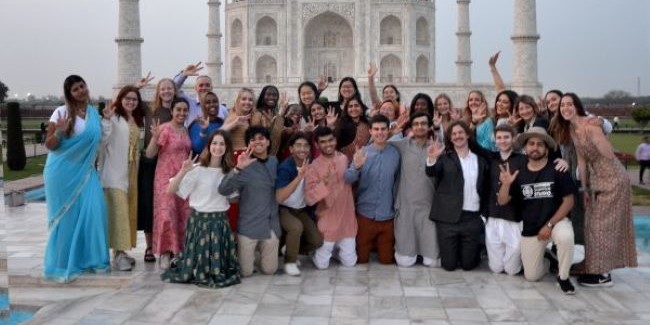
Anonymous $6.8 million gift will support Immersion Vanderbilt student projects
Explore story topics.
- Engineering and Technology
- External Story
- myVU Latest Headlines
- civil and environmental engineering
- Department of Civil and Environmental Engineering
- Immersion Vanderbilt
- Lori Troxel

IMAGES
VIDEO
COMMENTS
Abstract. Engineers are specialists in technical information. As the complexities of problems increase, there has been an increasing need for engineers to apply critical thinking in the context of problem solving. This article demonstrates the value and use of developing abstract thought in engineering, especially for students.
4. All engineering reasoning is done from some perspective or point of view. • Identify your specific point of view. • Consider the point of view of other stakeholders. • Strive to be fair-minded in evaluating all relevant points of view. 5. All engineering reasoning is based on data, information, and evidence. • Validate your data sources.
The model is briefly described and exemplified by questions asked by engineers in practice. The paper concludes with exercises suitable for the undergraduate and graduate engineering program. INTRODUCTION. The analysis and evaluation of our thinking as engineers requires a vocabulary of thinking and reasoning. The intellect requires a voice.
978-1-5090-3912-8/16/$31.00 ©2016 IEEE concern, the design of the course made particular efforts to link so-called "soft skills" of critical thinking as directly as possible the professional demands of a successful Engineering career, whether in practice or in research. The course design emphasized "epistemic humility: recognizing ...
Thinking, applies Richard Paul's Critical Thinking Model to the way engineers think. The model's purpose is to improve our thought by aiding in the analysis and evaluation of thought. The model is not restricted to engi-neering; its real power is its portability, adapting to any domain of thought. As engineers master the rudimentary skills ...
A method of assessment during various phases of critical thinking, i.e., initial design or set-up, testing of method or prototype, and evaluation of the results, of open-ended assignments in engineering for each year of the undergraduate course has been developed. 1.
urgent to train emerging engineers with adequate critical thinking skills. Critical thinking is not a matter of evaluating something in a negative sense but rather it is a healthy, constructive thinking process1. Critical thinking has to be exercised whenever a decision has to be made on a problem that has more than one solution.
Abstract: Design decisions for a critical thinking curriculum for engineering students serve as a point of departure to briefly describe an under-appreciated reason to emphasize critical thinking in engineering programs. An increasing focus on the role of context, environment and systems in shaping human judgement means that engineers should be especially aware of the propensity for designs ...
And if you are an engineer, or in a technical field, then critical thinking is all the more important to delivering the most effective and potentially novel, break-through solution you can. In this book series, we explore the key aspects of critical thinking: analytical skills, data analysis, interpretation, judgment, questioning evidence ...
According to the documents and studies of the Occupational Information Network (O*NET), we can define critical thinking in the following way []: Critical thinking is using logic or reasoning to identify the strengths and weaknesses of alternative solutions, conclusions or approaches to problems.In this research we identified that once engineering students halt performing certain activities and ...
Background and Motivation. "Critical thinking" is the ability to analyze carefully and logically information and ideas from multiple perspectives. This skill is demonstrated in the ability to. analyze complex issues and make informed decisions; synthesize information in order to arrive at reasoned conclusions; evaluate the logic, validity ...
The critical importance of fostering critica l thinking (CT) skills i n engineering students is well-. acknowledged. This study aimed to shed light on the existing methods used to teach a nd ...
Canada, 2014, 2016). Yet, many engineers do not receive an education that cultivates an orientation towards critical thinking and reflective decision-making that would foster a deep understanding of such "nontechnical" but vital aspects of engineering work- (Riley, 2008). Riley
Continuing to build on the analytical skills in Book 1 of the Critical Thinking Skills for Engineers E-Book Series -- this e-book (Book 2) moves into the context of a team, department, or larger organization -- where communication skills will play a vital role in your career success as an engineer. Often, you will need to share your thinking and conclusions with your employers, or with a group ...
The purpose of this study is to design strategies that develop critical thinking in engineering students, using three specific cognitive tools: (1) the enrichment of the vocabulary corpus; (2) the ...
In this book series, we explore the key aspects of critical thinking: analytical skills, data analysis, interpretation, judgment, questioning evidence, recognizing similarities and differences, creativity, communication, and skepticism. In this first book, we delve into analytical skills—the ability to examine something carefully—whether it ...
1. Habitual Thinking in the Engineering World • Path dependency • Industry Revolution and Technology Disruption • Mental Inertia and Innovation 1000-1045 2. Critical Thinking Framework for Engineering and Technology Companies (I) • Importance of Critical Thinking in Engineering • Habits of Mind: Curiosity, Humility and Scepticism
Generic engineering thinking skills apply to all technological disciplines. For example, engineering thinkers are clear as to the purpose at hand and the question at issue. ... Rather, it is essential that engineering students develop the generalizable critical thinking skills and dispositions necessary for effectively and professionally ...
Employability skills of engineering graduates • ^Thinking skills such as logical and analytical reasoning; problem solving; capacity to identify access and manage knowledge and information; personal attributes such as imagination; creativity and intellectual rigor; values such as ethical practice, persistence, integrity and tolerance,
The Thinker's Guide Library presents the framework of critical thinking across subject areas and audience levels to foster integration of critical reasoning throughout our world. 1. The Miniature Guide to Critical Thinking Concepts and Tools, Eighth Edition. 2. The Thinker's Guide to Analytic Thinking. 3.
Donald Norman, 1980, "Cognitive engineering and education," in Problem Solving and Education: Issues in Teaching and Research, edited by D.T. Tuna and F. Reif, Erlbaum Publishers. "We should be teaching students how to think. Instead, we are teaching them what to think." ... Critical thinking can be described as the scientific method applied by ...
In this fourth e-book in the series, we build upon our work thus far, by examining open-mindedness. To think critically, you need to be able to put aside any pre-conceived notions, assumptions, or judgments -- and simply analyze the information you have. As Christopher Dwyer, Ph.D., at the National University of Ireland, states: "Open-mindedness is about being open to changing your mind, in ...
Critical Thinking Skills for Enginners Book 1 - Free download as PDF File (.pdf), Text File (.txt) or read online for free.
Promoting critical and creative thinking in students is essential in the educational process, since it enables them to analyze deeply, question pre-established ideas and generate innovative ...
Immersion Vanderbilt was created to provide new ways for students to develop better critical thinking skills and a stronger ability to navigate a changing world.